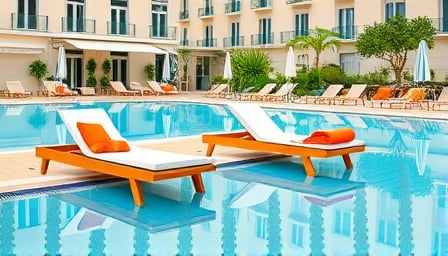Pierre & Vacances SA: A Closer Look at the Holiday Giant
In the ever-evolving landscape of the consumer discretionary sector, Pierre & Vacances SA stands as a towering figure, particularly within the hotels, restaurants, and leisure industry. With its roots deeply embedded in the holiday accommodation and property investment sectors, the company has carved out a significant niche for itself. However, as we delve deeper into its operations and financial health, questions arise about its sustainability and future prospects.
Financial Health: A Mixed Bag
As of June 3, 2025, Pierre & Vacances SA’s close price stood at 1.484 EUR, a figure that, while respectable, pales in comparison to its 52-week high of 1.68 EUR recorded on January 22, 2025. This decline from its peak raises eyebrows, especially when juxtaposed against its 52-week low of 1.242 EUR on June 27, 2024. Such volatility in stock price is a red flag for investors, signaling potential instability or underlying issues within the company’s operations or market strategy.
Moreover, the company’s price-to-earnings ratio of 33.76 is a testament to its high valuation, which could be a double-edged sword. On one hand, it reflects investor confidence in the company’s future growth prospects. On the other, it places immense pressure on Pierre & Vacances SA to deliver consistent, high-quality returns to justify its market valuation.
Operational Overview: A Dual-Segment Strategy
Pierre & Vacances SA operates through two primary segments: Tourism and Property Development. The Tourism segment, with its diverse portfolio of brands such as Pierre & Vacances, Adagio, and Center Parcs, caters to a wide range of holiday accommodation needs across Europe. Meanwhile, the Property Development segment focuses on the design, construction, renovation, and sale of various properties, targeting both individual investors and institutional buyers.
This dual-segment strategy allows Pierre & Vacances SA to tap into different market dynamics, potentially hedging against sector-specific downturns. However, it also exposes the company to a broader spectrum of risks, from fluctuating real estate markets to changing consumer preferences in holiday accommodations.
Market Position and Challenges
With approximately 280 sites and 45,000 apartments, Pierre & Vacances SA boasts a formidable presence in the European holiday accommodation market. Yet, this vast empire is not without its challenges. The company’s heavy reliance on the European market, particularly France and Germany, could be a vulnerability in the face of economic downturns or geopolitical tensions within the region.
Furthermore, the competitive landscape of the holiday accommodation sector is intensifying, with new entrants and technological innovations reshaping consumer expectations. Pierre & Vacances SA must navigate these waters carefully, leveraging its brand portfolio and operational expertise to maintain its market leadership.
Conclusion: A Path Forward
As Pierre & Vacances SA stands at this crossroads, the path forward is fraught with both opportunities and challenges. The company’s financial health, while robust in certain aspects, requires careful management to ensure long-term sustainability. Its operational strategy, though diversified, must be agile enough to adapt to the rapidly changing market dynamics.
In conclusion, Pierre & Vacances SA’s journey ahead is one of cautious optimism. With strategic adjustments and a keen eye on market trends, the company can continue to thrive in the competitive landscape of the consumer discretionary sector. However, failure to address its current challenges could see this holiday giant lose its footing in the sands of time.
